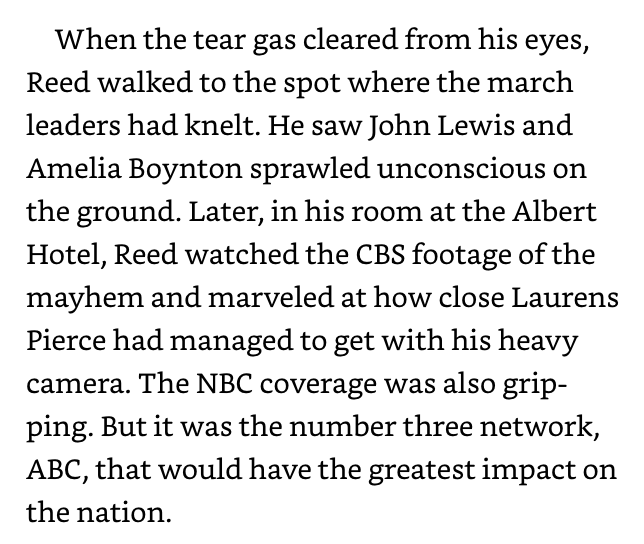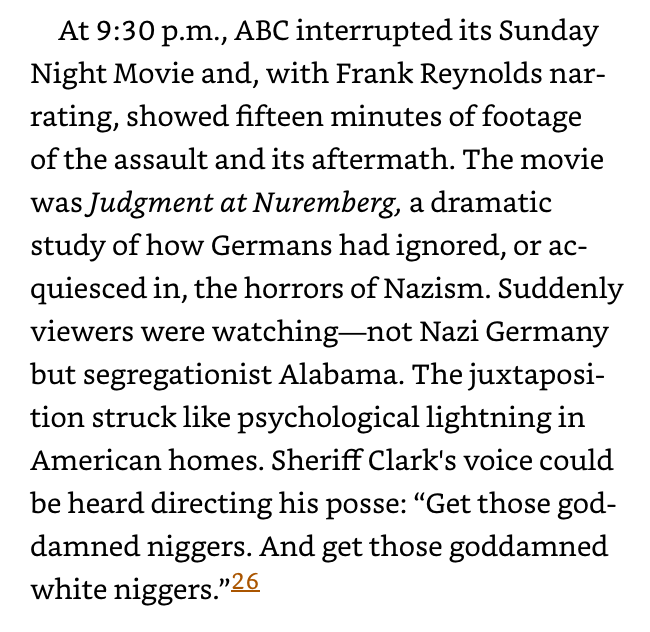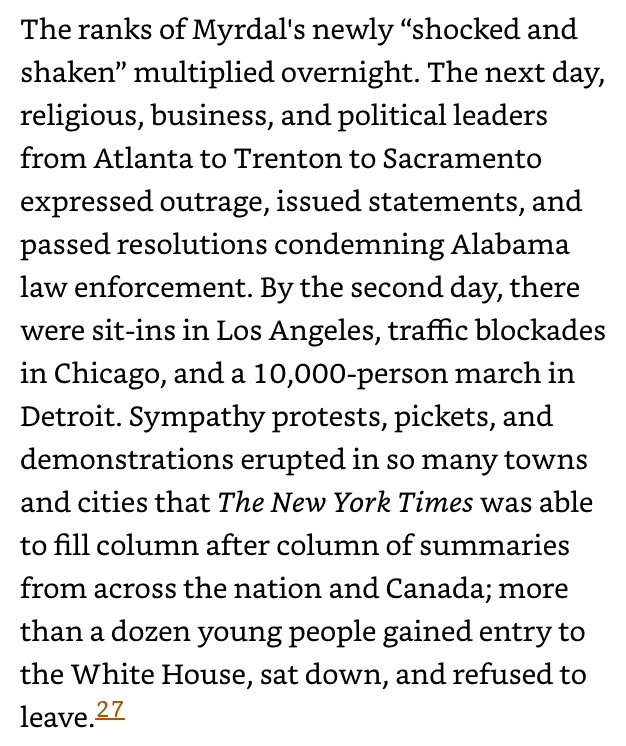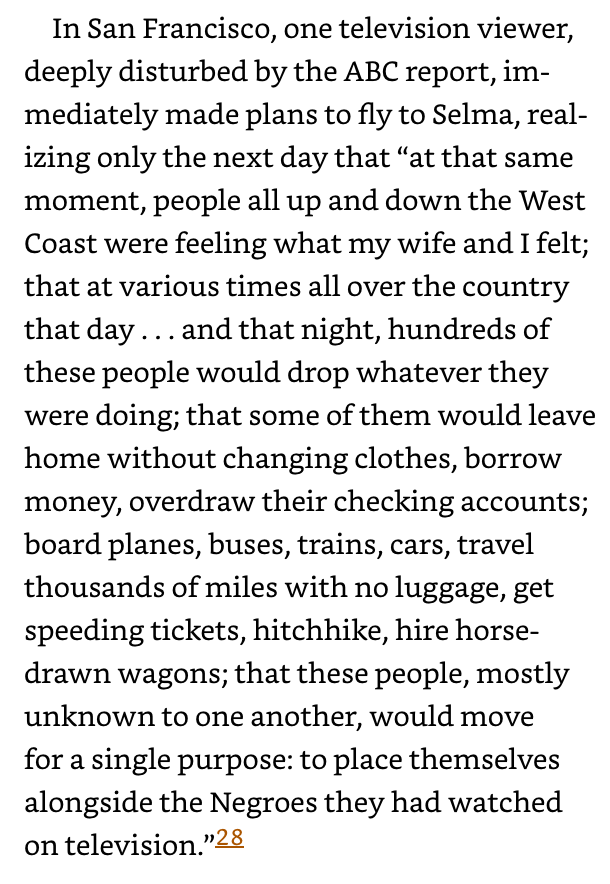The two lead segments on NPR this morning were ”Portland Mayor Wants Federal Agents Removed From His City” and “Civil Rights Leader John Lewis Never Gave Up Or Gave In.” The juxtaposition was striking and a remarkable echo of “Bloody Sunday.” 1/ https://www.npr.org/2020/07/19/890796423/civil-rights-leader-john-lewis-never-gave-up-or-gave-in">https://www.npr.org/2020/07/1...
The Pulitzer Prize winning book The Race Beat offers a superb history of how media covered the Civil Rights Movement. The section on “Bloody Sunday” highlights how brutal state violence made national news but also that one network “would have the greatest impact.” 2/
By coincidence, ABC was playing a Sunday Night Movie about Nazi war crimes called Judgement at Nuremberg. ABC interrupted the movie and “Suddenly viewers were watching—not Nazi Germany but segregationist Alabama.” 3/
Pioneering Swedish social scientist Gunnar Myrdal once argued “A great many Northerners, perhaps the majority, get shocked and shaken in their conscience when they learn the facts” about segregation. 4/
We often think of “news bubbles” as a contemporary issue. In the 1930s, 1940s and 1950s, however, White Americans lived in a news bubble through segregation and were either indifferent or hostile to the concerns of Black Americans. 5/
The Race Beat notes, “In America, the First Amendment kept the government in check, but the press, other than black newspapers and a handful of liberal southern editors, simply didn& #39;t recognize racism in America as a story.” 6/
A central strategy of the 1960s Civil Rights Movement was to puncture that bubble and, as John Lewis described it, ”dramatize injustice” so that those on the sidelines would be forced to bear witness to bigotry and state violence. 7/
”By his 20s, John Lewis had embraced a form of nonviolent protest grounded in the principle of ‘redemptive suffering’ — a term he learned from Rev. James Lawson, who had studied Gandhi’s style of nonviolent resistance during British colonial rule.” 8/ https://www.nytimes.com/2020/07/17/opinion/john-lewis.html?smid=tw-share">https://www.nytimes.com/2020/07/1...
At Selma, police & state troopers wielded clubs, bullwhips, and tear gas. John Lewis suffered a skull fracture. Fifty-eight people treated for injuries at the local hospital. The costs were enormously high but the strategy worked. 9/
“The next day, religious, business, and political leaders from Atlanta to Trenton to Sacramento expressed outrage, issued statements, and passed resolutions condemning Alabama law enforcement.” 10/
“Sympathy protests, pickets, and demonstrations erupted in so many towns and cities that The New York Times was able to fill column after column of summaries from across the nation.” 11/
”In San Francisco, one television viewer, deeply disturbed by the ABC report, immediately made plans to fly to Selma, realizing only the next day that ‘at that same moment, people all up and down the West Coast were feeling what my wife and I felt;‘”
12/
12/
Within five months of “Bloody Sunday,” the landmark 1965 Voting Rights Act was passed. But, of course, the story doesn’t end there. Repression, resistance and the fight for racial equality continue. 13/
In 2013, “the Supreme Court crippled the Voting Rights Act & states began unveiling measures limiting ballot access. At the time of the decision, John Lewis wrote the court had ‘stuck a dagger into the heart’ of a hard-won & still necessary law.” 14/ https://www.nytimes.com/2020/07/17/opinion/john-lewis.html">https://www.nytimes.com/2020/07/1...
Today, NPR reported in Portland ”federal agents dressed in camouflage & tactical gear took to the streets, unleashing tear gas, beating protesters bloody & pulling people into unmarked vans.” The mayor called the actions an “attack on democracy.” 15/ https://www.npr.org/2020/07/19/892757731/portland-mayor-ted-wheeler-wants-federal-agents-removed-from-his-city">https://www.npr.org/2020/07/1...
In 1963, John Lewis was the youngest person to speak at the March on Washington. Among his concerns: Kennedy’s civil rights bill had nothing in it ”that will protect our people from police brutality.” 16/ https://twitter.com/PDXzane/status/1284726088187310080">https://twitter.com/PDXzane/s...
As a result of the recent wave of #BlackLivesMatter  https://abs.twimg.com/hashflags... draggable="false" alt=""> protests, images of state violence against protesters are again making national news. 17/ https://twitter.com/JoaquinCastrotx/status/1284907182912425984">https://twitter.com/JoaquinCa...
https://abs.twimg.com/hashflags... draggable="false" alt=""> protests, images of state violence against protesters are again making national news. 17/ https://twitter.com/JoaquinCastrotx/status/1284907182912425984">https://twitter.com/JoaquinCa...
Though significant progress has been made since the 1960s, a half-century later John Lewis’ struggle for voting rights and against police brutality remain just as urgent. 18/
Before he died, “With Lewis’ customary eloquence, he urged Congress to restore the Voting Rights Act, describing the right to vote as ’almost sacred’ and ‘the most powerful nonviolent tool we have in a democracy.‘” fin/ https://www.nytimes.com/2020/07/17/opinion/john-lewis.html">https://www.nytimes.com/2020/07/1...
For more, I highly recommend The Race Beat by Gene Roberts and Hank Klibanoff. https://bookshop.org/books/the-race-beat-the-press-the-civil-rights-struggle-and-the-awakening-of-a-nation/9780679735656?aid=8671">https://bookshop.org/books/the...
For more about my research on 1960s civil rights protests, see this thread that summarizes my main findings. https://twitter.com/owasow/status/1265709670892580869">https://twitter.com/owasow/st...

 Read on Twitter
Read on Twitter





